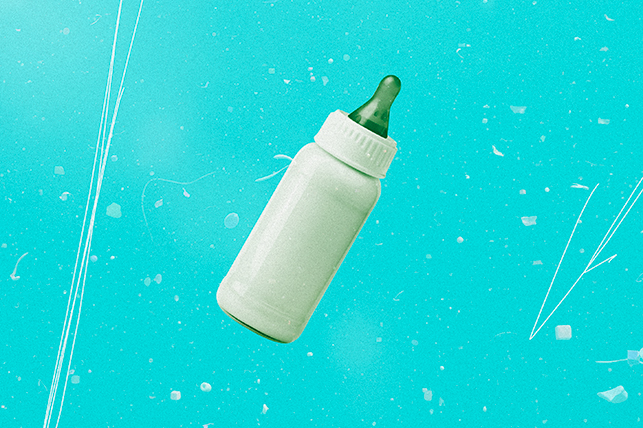Study Identifies Breast Cancer-Linked Chemicals in Food Packaging

Key Points
- Numerous studies have linked various chemicals in everyday products to chronic conditions, including reproductive problems and certain cancers.
- Nearly 200 chemicals associated with increased breast cancer risk are used in common food packaging materials, according to the latest research.
- Many of these chemicals may migrate from packaging into food, potentially posing a serious threat to human health.
Many foods can ruin your sex drive. Now, it appears as though the packaging of food is linked to increased rates of breast cancer.
Here's what you need to know about the recent findings and how to reduce your risk of breast cancer.
What are breast carcinogens?
Breast carcinogens, also known as mammary carcinogens, are chemicals research has shown to increase the risk of breast tumors.
A recent study found 189 breast cancer-linked chemicals in common food packaging and tableware. Many of these toxins, researchers say, may migrate into food.
These toxins may do so through several mechanisms, such as causing oxidative stress or chronic inflammation, altering DNA, or affecting hormone levels or signaling, according to a January 2024 study by the Silent Spring Institute.
Researchers have identified 921 such breast cancer-linked chemicals so far.
Now, 189 of these breast cancer-linked toxins—including PFAS (forever chemicals), bisphenols and phthalates—are common in food packing materials and tableware, such as disposable cups and plates, indicated the 2024 study by the Food Packaging Forum.
The report appeared in the journal Frontiers in Toxicology in September 2024.
Evidence suggested of the total 189 toxins, 143 are found in plastics, while 89 are used in cardboard or paper materials. People regularly consume at least 76 of these chemicals, as they have leached into food, according to the study authors.
International regulatory agencies in the United States, the European Union, South America and China have classified 40 of those 76 chemicals as harmful, researchers said.
The Food Packaging Forum, based in Zurich, Switzerland, compiles data from thousands of global scientific studies to maintain a vast database of chemicals used in food packing. The same group released a report identifying 3,600 chemicals which transfer from packaging into food products, also in 2024.
Prior research has linked 79 of those 3,600 chemicals to cancer, genetic mutations, and endocrine and reproductive problems, suggested the authors of the report, published in the Journal of Exposure Science & Environmental Epidemiology.
Besides eating microplastics and contaminated foods, people can ingest forever chemicals through drinking water, air and various consumer products, according to the U.S. Environmental Protection Agency (EPA).
The same goes for bisphenols and phthalates, which are similarly ubiquitous.
The former—which includes bisphenol-A (BPA)—is frequently used in epoxy resins to coat the inside of products such as food cans and bottle tops.
In addition to raising the risk of cancer, BPA may contribute to high blood pressure, type 2 diabetes and cardiovascular disease. BPA may also adversely affect the brains and prostate glands of fetuses and children.
Phthalates—which make materials, such as plastic, softer and less brittle—are known endocrine disruptors which may contribute to various health issues, including cancer, fertility problems, early puberty, obesity, diabetes, neurological problems and cardiovascular illnesses, according to the Environmental Working Group (EWG).
Recommended
- Diagnosing Breast Cancer in Younger Women: More than 27,000 women under age 45 are expected to be diagnosed with breast cancer this year.
- Women Should Start Screening Mammograms at Age 40: The new 2024 mammogram guidelines could help improve breast cancer survival rates.
- How Fast Does Breast Cancer Spread?: It could be months or it could be years before your breast cancer spreads, so here's a rough idea of what you might expect.
How can you reduce your exposure to potential breast carcinogens?
It isn't possible to avoid toxic chemicals altogether. Scientists have found microplastics in human testes, blood, breast milk and brains.
In New York City, a test of maternal urine revealed more than 90 percent of those tested had BPA in their bodies, indicated the report. The researchers also detected BPA in more than 95 percent of children's samples, with larger concentrations for 3-5 years old.
Who is to blame? How can you fix this problem of toxic-filled packaging?
The onus should be on companies and governments—and not individuals—to restrict the use of harmful substances, stressed the authors of the Frontiers in Toxicology report.
However, there are steps you can take to reduce your likelihood of developing breast cancer.
"The potential for cancer prevention by reducing hazardous chemicals in your daily life is underexplored and deserves much more attention," said Jane Muncke, managing director of the Food Packaging Forum and co-author of the study, in a press release.
Consider the following ways to avoid breast cancer-linked chemicals, suggested the Silent Spring Institute, a nonprofit investigating environmental causes of breast cancer:
- Avoid canned food or moist food packaged in plastic or lined cardboard
- Avoid microwaving food in plastic containers, as heat can release certain chemicals into food
- Avoid nonstick pans, especially older or damaged ones, and choose materials like stainless steel or ceramic
- Avoid plastic water bottles and coolers
- Choose organic food when possible, as these are less likely to be exposed to pesticides, which contain harmful chemicals
- Choose smaller, younger seafood, as toxins often accumulate in fish
- Trim fat and skin from fish and meat, and drain fat accumulated during cooking, as pollutants tend to accumulate in fat
- Toss plastic food storage containers and use glass instead
- Use a glass or stainless steel French press or drip coffee maker instead of plastic
- Use a solid block or granulated carbon water filter
What are other ways to decrease my breast cancer risk?
Breast cancer rates are rising among all age groups–especially younger women (indicated a 2024 report), and contaminated food is one of several potential reasons.
The Centers for Disease Control and Prevention (CDC) recommends the following other ways to reduce your risk of breast cancer:
- Avoid smoking
- Breastfeed your babies, if you can
- Don't drink alcohol, or do so in moderation
- Eat a balanced diet
- Maintain a healthy weight
- Stay physically active
- Talk to your doctor about the risks of birth control pills or hormone replacement therapy if you use such treatments
Properly performed, regular breast self-exams and check-ups with your doctor are also crucial.
The United States Preventive Services Task Force recommends most women start getting mammograms for breast cancer screening at age 40. However, if you're high-risk, your doctor may recommend starting earlier or getting them more frequently than your peers.
The bottom line
You can't completely evade endocrine disruptors, forever chemicals and other potential toxins, but there are plenty of things you can do to lower risk. Along with the tips above, understanding your personal risk of developing breast cancer is a solid place to start.
Talk to your doctor to determine your breast cancer risk factors and what lifestyle changes or medical interventions may help to offset them.


















